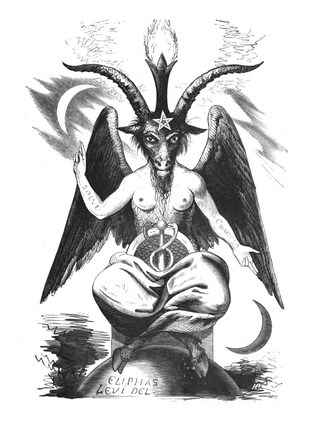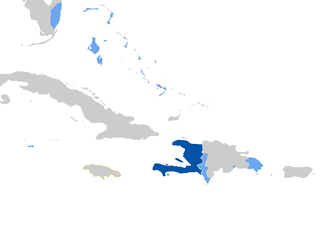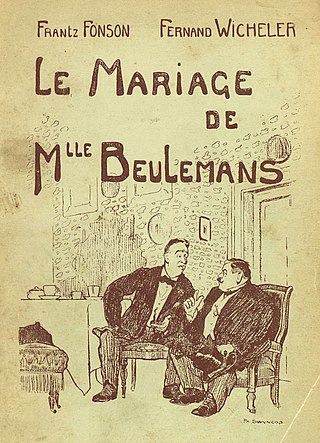Related Research Articles
Speaking in tongues, also known as glossolalia, is an activity or practice in which people utter words or speech-like sounds, often thought by believers to be languages unknown to the speaker. One definition used by linguists is the fluid vocalizing of speech-like syllables that lack any readily comprehended meaning. In some cases, as part of religious practice, some believe it to be a divine language unknown to the speaker. Glossolalia is practiced in Pentecostal and charismatic Christianity, as well as in other religions.
A protest song is a song that is associated with a movement for protest and social change and hence part of the broader category of topical songs. It may be folk, classical, or commercial in genre.

Baphomet is a deity which the Knights Templar were accused of worshipping that subsequently became incorporated into various occult and Western esoteric traditions. The name Baphomet appeared in trial transcripts for the Inquisition of the Knights Templar starting in 1307. It first came into popular English usage in the 19th century during debate and speculation on the reasons for the suppression of the Templar order. Baphomet is a symbol of balance in various occult and mystical traditions, the origin of which some occultists have attempted to link with the Gnostics and Templars, although occasionally purported to be a deity or a demon. Since 1856 the name Baphomet has been associated with the "Sabbatic Goat" image drawn by Éliphas Lévi, composed of binary elements representing the "symbolization of the equilibrium of opposites": half-human and half-animal, male and female, good and evil, etc. Lévi's intention was to symbolize his concept of balance, with Baphomet representing the goal of perfect social order.

Fernando Arrabal Terán is a Spanish playwright, screenwriter, film director, novelist, and poet. He was born in Melilla and settled in France in 1955. Regarding his nationality, Arrabal describes himself as "desterrado", or "half-expatriate, half-exiled".

Haitian Creole, commonly referred to as simply Creole, or Kreyòl in the Creole language, is a French-based creole language spoken by 10–12 million people worldwide, and is one of the two official languages of Haiti, where it is the native language of the vast majority of the population. Northern, Central, and Southern dialects are the three main dialects of Haitian Creole. The Northern dialect is predominantly spoken in Cap-Haïtien, Central is spoken in Port-au-Prince, and Southern in the Cayes area.

Françoise Madeleine Hardy is a retired French singer-songwriter. Mainly known for singing melancholic sentimental ballads, Hardy rose to prominence in the early 1960s as a leading figure of the yé-yé wave. In addition to her native French, she also sang in English, Italian and German. Her career spanned more than fifty years with over thirty studio albums released.
Anglo-Norman literature is literature composed in the Anglo-Norman language and developed during the period of 1066–1204, as the Duchy of Normandy and the Kingdom of England were united in the Anglo-Norman realm.

Albert Gleizes was a French artist, theoretician, philosopher, a self-proclaimed founder of Cubism and an influence on the School of Paris. Albert Gleizes and Jean Metzinger wrote the first major treatise on Cubism, Du "Cubisme", 1912. Gleizes was a founding member of the Section d'Or group of artists. He was also a member of Der Sturm, and his many theoretical writings were originally most appreciated in Germany, where especially at the Bauhaus his ideas were given thoughtful consideration. Gleizes spent four crucial years in New York, and played an important role in making America aware of modern art. He was a member of the Society of Independent Artists, founder of the Ernest-Renan Association, and both a founder and participant in the Abbaye de Créteil. Gleizes exhibited regularly at Léonce Rosenberg's Galerie de l’Effort Moderne in Paris; he was also a founder, organizer and director of Abstraction-Création. From the mid-1920s to the late 1930s much of his energy went into writing, e.g., La Peinture et ses lois, Vers une conscience plastique: La Forme et l’histoire and Homocentrisme.

Louis Gaston Adrien de Ségur was a French bishop and charitable pioneer.

Le Mariage de mademoiselle Beulemans is a three-act comedy play written in 1910 by the Belgian playwrights Frantz Fonson and Fernand Wicheler. It is a bourgeois situation comedy of manners and character, and a satire on the aspirations and issues of the lower middle class that emerged in Brussels in the early twentieth-century.

Ligier Richier was a 16th-century religious sculptor working in Lorraine, France and known in particular for his depictions of scenes from the "Passion of Christ". The various episodes of the Passion, between the arrest and the crucifixion of Christ, as recounted in the Gospels, were increasingly subject to representation in the Arts towards the end of the Middle Ages, in tandem with the growing popularity of the staging of theatrical mystery plays.
The prix Broquette-Gonin was a former prize awarded by the Académie française.

BAC Films is a French film production and distribution company. Based in Paris, the company was founded in 1986 by Jean Labadie, Éric Heumann, and Stéphane Sorlat. Capital shares of the company were re-allocated in 1988 when Vivendi took 10% followed by a 20% stake in the capital of the company, which allowed BAC Films to make major and ambitious acquisitions.
Denise Benoît was a French actress and singer, active across a wide range of genres on the stage, radio and television. Other members of her family were musicians.

Glorious is a French Christian (Catholic) rock and worship music group, originally from Valence, Drôme, and based in Lyon, France. It was formed in 2000, following the World Youth Day, by three brothers from Valence.
References
- ↑ Hammarström, Harald; Forke, Robert; Haspelmath, Martin; Bank, Sebastian, eds. (2020). "Mure". Glottolog 4.3.
- ↑ Birchall, Joshua (2013). "A look at the Rokorona language". STUF - Language Typology and Universals. 66 (3). doi:10.1524/stuf.2013.0013. ISSN 2196-7148. S2CID 62461567.
- 1 2 3 4 5 6 de Créqui-Montfort, Georges and Paul Rivet. 1913. Linguistique Bolivienne: La Famille Linguistique Čapakura. Journal de la Société des Américanistes X: 119-172.
- 1 2 Teza, Emile. 1868. Saggi Inediti di lingue Americane. Annali delle Università Toscane (parte prima): Scienze Neologiche X. 117-143.
- ↑ Hervás y Panduro, Lorenzo. 1800. Lenguas y naciones Americanas. (Catálogo de las lenguas de las naciones conocidas, y numeracion, division, y clases de estas, I.) Madrid: Imprenta de la Administración del real arbitrio de beneficencia. xvi+396pp.
- ↑ Cosme Bueno. 1770. Descripción del Obispado de Santa Cruz. (El conocimiento de los tiempos, ephemeride del año de 1771.) Lima: En la Imprenta Real; Calle de Palacio. 56pp.